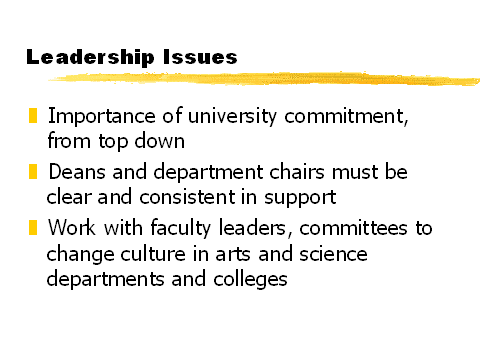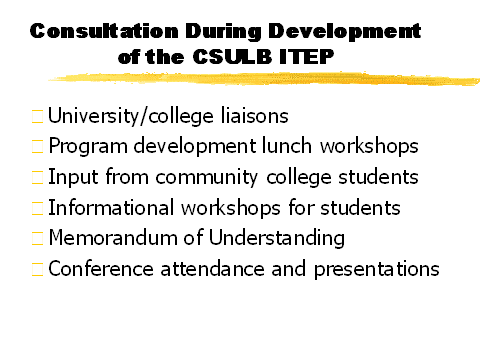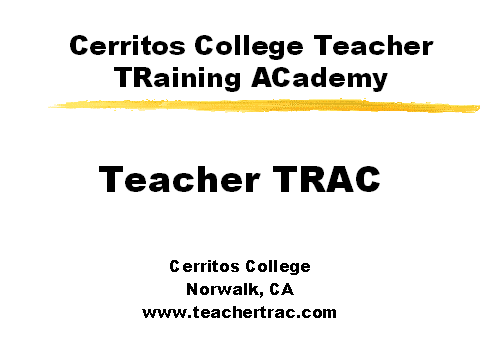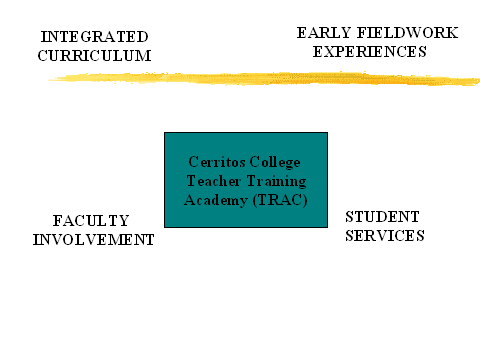

 |
 |
![]()
 |
Working Group Session # 12 - Jean Houck
|
Click here to download Power Point version of Dean Houck's presentation.
The collaborative teacher preparation program that has
been put in place in Long Beach, California enables students to enroll at
Cerritos College in Norwalk, California for two years in their teacher education
program Teacher TRAC and complete their programs at California State University,
Long Beach. The program is distinctive in several ways: (1) community college
faculty and university faculty have collaborated to align the courses in the
teacher preparation program and enable students to transfer smoothly and (2) the
mathematics component of the program has been strengthened to ensure that the
new teachers enter elementary schools with stronger subject matter preparation
in mathematics.
This paper will describe the setting in Long Beach, California, the partners in
the collaborative teacher education program, and the mathematics preparation
that the future elementary teachers receive.
California State University, Long Beach and Cerritos College, located in nearby
Norwalk, California, are higher education institutions located in a diverse
urban area in Los Angeles County, California. A review of the demographics of
the institutions and one of the large local school districts, Long Beach Unified
School District (enrollment: 94,000) illustrates the diversity of the area and
its educational institutions. It will be noted that only 43% of the K-12
students are English only students, and the remainder speak a range of
languages. The largest groups of language minority students are Spanish,
Vietnamese, Khmer (Cambodian), but there are also substantial numbers of many
other languages, as Southern California is one of the most ethnically,
linguistically, and racially diverse areas of the United States.

At the community college and the university level, the presidents, deans, and department chairs have been very supportive of teacher preparation. The President of Cerritos College, Dr. Fred Gaskins, stated his commitment to the partnership and urged his faculty and staff to develop the program. At the university, the President, Dr. Robert Maxson, said to the community college representatives, "We need you more than you need us", and later, "We will work with you to articulate our teacher preparation program."

During development of the Integrated Teacher Education Program (ITEP) the university received funding from the James S. and John L. Knight Foundation to develop the curriculum in the integrated program. Later, the community college received funding from the state of California as part of the Teacher Development and Reading programs for community colleges. Both funding sources included professional development for faculty and a series of workshops over a period of two years. These sources have brought faculty together from Arts and Science and Education at the two institutions to work on the courses in the first two years of the teacher preparation program. Faculty also attended conferences together and communicated on a range of levels about the program they were developing. After the first year of work, a memorandum of understanding was developed to set the details of the agreement for the two institutions (See Appendix A for a copy of the Memorandum of Agreement).

The goal for the articulation of the teacher education
program was for students to be able to complete two years at the community
college, and then transfer to the university, without having to repeat any
courses or suffer any other delays to the swift completion of their programs. To
do this, the partners discussed the articulation of courses and fieldwork. They
were sensitive to the fact that advising in the programs had to be articulated,
and there were frequent visits from community college people to the university,
and from university people to the community college to ensure that advising was
handled smoothly.

Cerritos College administration and faculty placed the pre-teaching program, Teacher TRAC, as a first priority. The university faculty and administration were amazed at the speed with which Cerritos College faculty placed the structural and student support system in place and began work on the curriculum. When the Dean of the College of Education from California State University, Long Beach visited Cerritos College, the community college faculty proudly showed the "one stop center" they had built. The Teacher TRAC one stop center is located in a very prominent location (a front corner cubicle) in the large, bustling centralized student services center for the entire community. Make no mistake, the message is clear at Cerritos College that the pre-teaching program, Teacher TRAC, is important and very visible! The component of the Teacher TRAC program are illustrated below:

The faculty from both the community college and the university held numerous meetings discussing the curriculum for the future elementary teachers. Faculty from both institutions are knowledgeable about the standards for instruction in kindergarten through grade eight classrooms, and the faculty spent many hours discussing what courses were needed to provide the best curriculum, aligned with those standards. In order to be effective teachers in the program, faculty from both institutions discussed their own pedagogical practices, and how they could model best practice for the students. The university received a grant for infusing technology in teacher preparation (Preparing Tomorrowís Teachers to Use Technology, PT 3) and linked the grant activities with the community college.
The subject matter preparation of teachers in the Integrated Teacher Education Program (ITEP) has been strengthened, and includes a math course in each year, freshman, sophomore, junior, and senior, taught by a faculty member from the Department of Mathematics (years one and two at the community college, and years three and four at the university). Also in the fourth year, is a course on mathematics pedagogy that is taught by College of Education faculty. Students in ITEP must choose from one of (only) four concentrations in basic subject areas taught in elementary schools, and the mathematics concentration has been redesigned to be more appropriate to the needs of elementary teachers and students. Limiting the selection of concentration to the "Big Four" has greatly increased the number of students selecting mathematics. The courses in the core and the mathematics concentration are listed in Appendix B.
The ITEP Program represents a strengthening of the subject
matter preparation in mathematics of elementary teachers. Graduates of the
program are expected to be much more knowledgeable about mathematics and the K-8
mathematics standards. The collaboration between Cerritos College faculty and
the faculty of California State University, Long Beach is very unique and
represents the very best in collaboration. It shows that faculty from a
community college and a university can forget their different positions and
roles and concentrate on developing a high quality teacher preparation program
based upon what future teachers need to know and to be able to do to be
effective in teaching mathematics to children in Americaís classrooms!

Cerritos College (CC) and California State University,
Long Beach (CSULB) hereby agree to collaborate un a seamless teacher education
process designed to prepare additional, highly qualified teachers for elementary
schools in Southern California. This agreement is valid as of May 10, 1999.
Curriculum
The Integrated Teacher Education Program at CSULB may be completed in four calendar years. The program is a pilot program for 1999-2001. This agreement applies to the pilot and will be revised to reflect the subsequently approved ITEP program. The CC and CSULB partnership described in this memorandum of understanding (MOU) provides for an articulated curriculum which includes the first two years in the Cerritos College Teacher Training Academy (Teacher TRAC) and the second two years in the Integrated Teacher Education Program (ITEP) at California State University, Long Beach. Students may complete their bachelorís degree in Liberal Studies and the multiple subject credential by:
Students at CC who complete an approved curriculum pathway
will receive full credit for courses completed toward the requirements for the
CSULB Liberal Studies (Track One) Program. Students recommended by Cerritos
College as having fulfilled all course and achievement requirements for years
one and two, (including specified additional coursework) will qualify for
admission into the CSULB Liberal Studies Program at the third year level of the
program.
Field Experiences
The first 40-80 hours of the required 120 hours of service learning/field
experience in the Integrated Teacher Education Program (ITEP) and the Liberal
Studies Track One Program may be completed at CC. Cerritos College faculty will
participate in the CSULB Service Experiences for ReVitalizing Education (SERVE)
training prior to assuming responsibility for supervising community college
teacher preparation studentsí service learning experiences. Service learning
hours will be verified on CSULB forms and reported to the CSULB Center for
Collaboration in Education prior to/upon studentís enrolling in courses at CSULB.
Training and placement if CC students will be coordinated through the CSULB
Center for Collaboration in Education.
Academic Advising
The Transfer Center Director will be the contact person for advising at CC and the Director of the Liberal Studies Program will be the contact person for advising at CSULB. The Director of the Cerritos College Teacher TRAC will assume primary responsibility for providing advisement to ITEP and Liberal Studies students transferring to CSULB to pursue the Liberal Studies or ITEP program. Designated staff at the community college and the university will jointly plan and implement advisement for students to move smoothly from the community college into the third year of preparation at CSULB. Cerritos College students will visit CSULB during their two years at CC for orientation, advisement and potential designated courses. University staff/faculty will visit the CC Teacher TRAC Director and/or students at least once each semester.
Technology
Cerritos College Teacher TRAC students will receive
special training in integrating technology into the classroom. First and second
year CSULB students in ITEP and Liberal Studies Track One will be offered the
opportunity for similar training in the Cerritos College Innovation Center
through cross enrollment.
Admission
ITEP: Upon (1) successful completion of the
specified ITEP articulated courses offered at CC; (2) successful completion of
requirements for admission to CSULB; and (3) successful completion of the
requirements for admission to the first phase of the multiple subjects
credential program, CC students may enroll in the junior/third year in the CSULB
Integrated Teacher Education Program (ITEP). Approved pathway curriculum will
detail all course standards and application requirements and will be given to
the Cerritos College Teacher TRAC students. It is anticipated that, for full
time students not in need of remedial courses successfully completing the
suggested sequence of courses, the time from initial enrollment at the community
college to completion of the Integrated Teacher Education Program degree and the
multiple subject credential will be four calendar years. Any variation from
approved curricular pathways may result in additional time or completion of the
program.
Liberal Studies, Track I: For those CC students who are unable to commit
to the full time course of study required for completion of ITEP, the Liberal
Studies Track I program exists as an alternate pathway. Articulation of courses
which may be taken at CC to meet CSULB Track One requirements is already in
place. Completion of the courses outlined in the existing agreement for Track
One provides CC students with the ability to successfully complete requirements
for transfer admission to CSULB, and subsequent matriculation into the Track One
program.
Upon admission to the CC TRC, students will receive a letter from CSULB
affirming the collaboration between CC & CSULB in the seamless preparation
process for prospective elementary teachers.
By spring, 2001the parties will review the agreement and revise as necessary to
ensure that the curricula for both ITEP and Liberal Studies Track One are
aligned.
Choose one course from:
ASAM 100. Language Skills (3)
B/ST 100. Language Skills (3)
CHLS 104. Bilingual Communication Skills-English (3)
ENGL 100. Composition (3)
ENGL 100W. Composition (3)
Take:
ENGL 309. Applied Composition: Explorations in Childrenís Writing (4) F,S
Choose one course from:
COMM 130. Essentials of Public Speaking (3)
COMM 335. Persuasive Speaking (3)
Take: **
ENGL 481. Childrenís Literature (3)
** Must be concurrently enrolled in EDEL 453B
Choose one course from:
CD/LING 329. Introduction to Language Acquisition (3)
**EDP 454 Development of Communication Skills in Bilingual Classrooms
**Must be concurrently enrolled in EDEL 453A
Take:**
C/LA 400. Evaluating Literacy (3)
![]()
Take:
MTED 105. Activity-Based Probability and Statistics for Elementary and Middle School Teachers (3)
Prerequisites: Three years of high school mathematics including algebra, geometry, and intermediate algebra (or MATH 010), or the equivalent. Activity-based exploration of randomization, data representation, measures of central tendency and dispersion. Analysis of experiments requiring hypothesizing, experimental design and data gathering. Basic laws of probability and set theory, combinations, permutations, and simulations. Algebraic thinking will be used throughout the course. Enrollment limited to students seeking a Multiple Subject teaching credential. Not open for credit to Mathematics majors. (Lecture 2 hrs., Activity 2 hrs.) Traditional grading only.
Take:
MTED 110. The Real Number System for Elementary and Middle School Teachers (3)
Prerequisites: Three years of high school mathematics including algebra, geometry, and intermediate algebra (or MATH 010), or the equivalent. Introduction to problem solving processes and strategies. Development and analysis of the structure and operations of the real number system. Concept and process development using appropriate models, manipulatives, and activities. Not open to students with C or better in MATH 110. Enrollment limited to students seeking a Multiple Subject teaching credential. Not open for credit to Mathematics majors. (Lecture 2 hrs., Activity 2 hrs.)
Take:
MTED 211. Geometry and Measurement for Elementary Teachers (3)
Prerequisites: "C" or better in MTED 110 and one year of high school geometry. Formerly MTED 111. Problem solving with particular focus on making tables and patterning, informal geometry, congruence, similarity, constructions, transformations, tessellations, and measurement involving both English and Metric units in 1, 2 and 3 dimensions. Computer language, such as Logo and/ or geometry drawing utility, such as Geometerís Sketchpad, will be integrated into the course. Emphasis will be on hands-on modeling of real-world geometric situations. Not open to students with "C" or better in MATH/MTED 111. Enrollment limited to students seeking a Multiple Subject teaching credential. Not open for credit to Mathematics majors. (Lecture 2 hrs., Activity 2 hrs.)
* MTED 312. Geometry and Measurement for Mathematics Specialists in Elementary and Middle Schools (3)
Prerequisites: MTED 110 and one year of high school geometry. Prerequisite or co-requisite MTED 278 or MTED 301 or the equivalent. Focus on exploration, conjecture and justification of geometric relationships and applications that are relevant to teaching geometry through the middle grades. Topics include: problem solving, informal geometry, the nature of proof, introduction to non-Euclidean geometry, congruence, similarity, constructions, transformations, tessellations, and measurement involving both English and Metric units in 1, 2 and 3 dimensions. Technology involving a geometry drawing utility, such as Geometerís Sketchpad, will be used extensively in the course. (Lecture 2 hrs., Activity 2 hrs.) Traditional grading only. Solving, mathematical connections, mathematical structures, mathematical conjecture and proof, mathematical communication at various levels, use of manipulatives and technology, assessment alternatives. Instructional experiences involving mathematics required in college-age settings. Observation/interview experience involving mathematics required in non-educational settings. Portfolio assemblage required. Intended for students preparing to enter the Single Subject Credential Program. Not open to students with credit in MATH 411. (Lecture 2 hrs., activity 3 hrs.)
* MTED 312 Limited to students who plan to complete the MATH concentration
Take:
MTED 402. Problem Solving Applications in Mathematics for Elementary and Middle School Teachers (3)
Prerequisites: "C" or better in both MTED 110 and one of MTED 211 (formerly MTED 111) or MATH 355 or the equivalent and a course in Critical Thinking with a grade of "C" or better. Focusing on problem solving processes and strategies, this course will bring together and apply content from many areas of mathematics and make use of computer technology and/or graphing calculators. The course will illustrate problem solving as a framework for developing questioning strategies that foster understanding of algebra and geometry. Topics include real-world applications.
![]()
a. Take:
CHEM 105. Chemistry Explorations (1)
b. Take:
PHSC 112. Introduction to the Physical Sciences (3) F,S
Choose one course from:
GEOL 102. General Geology (3)
or
GEOL 104. Geology Laboratory (1)
* GEOL 106. Earth Science for Teachers (4)
Take:
BIOL 200. ## General Biology (4) F,S
Take:
SCED 401. A Process Approach to Science (3)
![]()
Choose one course from:
HIST 172. Early United States History (3)
HIST 300. The United States Past and Present (3)
Take:
HIST 473. California History (3)
Choose one course from:
POSC 100. Introduction to American Government (3)
POSC 391. American Government (3)
Choose one course from:
AIS/ASAM/B-ST/CHLS 215 United States Diversity and Ethnic Experience (3)
W/ST 319. The Ethnic Experience in the U.S. (3)
Choose one course from:
*HIST/GEOG 250 World History and Geography: Origins to 1500 (4)
HIST 211. World History: Origins to 1500 (3)
plus
GEOG 100. World Regional Geography (3)
Take:
C/LA 471 History/Social Science Content and Standards for Elementary Classrooms (2)
** Must be concurrently enrolled in EDEL 471 & EDEL 473
![]()
Take:
MUS 180. Exploring Music (3)
Take:
ART 300. Art, Adolescence, and the Child (3)
Choose one course from:
C/LT 124 Introduction to World Theatre and Drama (3)
C/LT 342I
DANC 110. Viewing Dance (3)
DANC 279. Exploring Dance: The Language of Movement (3)
THEA 113. Introduction to Acting (3)
THEA 122. Appreciation of Theatre Arts (3)
THEA 124. Introduction to World Theatre and Drama (3)
THEA 324I. Theatre Today (3)
Choose one course from:
PHIL 100. Introduction to Philosophy (3)
PHIL160. Introductory Ethics (3)
PHIL 160W. Introduction to Ethics (4)
PHIL 203. History of Early Western Philosophy (3)
PHIL 204. History of Modern Western Philosophy (3)
PHIL 305. Philosophy in Literature (3)
R/ST 100. Introduction to Religion (3)
R/ST 202. Religion and Society (3)
R/ST 485. Contemporary Religious Thought (3)
Take:
L/ST 404 Arts and Values
![]()
Choose one from:
* ETEC 110. Introduction to Computers as Tools (1)
ETEC 444. Computer Technology in Education, Level I (3)
* ETEC 110 is the preferred course
Choose one course from:
A/ST 190. The Tao Primer of Basic Reasoning (3)
COMM 131. Argumentation (2)
plus
COMM 131W. Argumentation Workshop (1)
ENGL 102. Critical Reading and Writing (3)
HIST 101. Facts, Evidence and Explanation (3)
PHIL 170. Critical Reasoning (3)
PSY 130. Critical Thinking (3)
Take:
EDP 180. Family School Partnerships (3)
Choose one course from:
FCS 219. Stress, Coping and Resiliency for the Professional Educator (3)
FCS 319. Family Stress and Coping (3)
Choose one course from:
EDP 301. Child Development and Learning: A Cross-Cultural Perspective (1-3)
HDEV 307I. Human Development: Childhood Through Adolescence (3)
Take:
KPE 467. Fundamentals of Personal Training (3)
Take:
HSC 411A. Health Science for Elementary Teachers (3)
![]()
Take:
EDEL 100. Introduction to Teaching and Learning in Diverse Contemporary Classrooms (1)
Take:
EDEL 200. Introduction to the Education Profession (3)
Take:
EDEL 300. Democratic Teaching in a Digital Age (3)
![]()
Take:
MTED 301. Computer Applications in Mathematics for Teachers (3)
Prerequisites: One year of high school geometry and one of MTED 110 or MATH 122. Formerly MTED 278. Course designed for pre-service or in-service teachers. Introduction to computer technology and its applications to mathematics classrooms; software evaluation; survey of teacher tools such as spreadsheets and databases; e-mail, computer-based collaborative tools and applications using the Internet; mathematics using technology; introduction to programming; issues about computer and other technology use in the schools; integration of computer technology into the mathematics classroom. Open for credit to Single Subject mathematics and Multiple Subject credential students only. (Lecture 2 hrs., Activity 2 hrs.) Not open for students with credit in MATH/MTED 278.
Take:
MTED 315. History of Mathematics for Mathematics Specialists in Elementary and Middle Schools (3)
Prerequisites: MTED 110 and MTED 312. This course develops mathematics ideas throughout history with an orientation toward the various civilizations and cultures that contributed those ideas. The course covers the history of most areas of mathematics relevant to the K-9 curriculum, especially arithmetic, algebra, geometry, and their interrelationships. The cross-cultural view of mathematics will be emphasized. Also included are historical origins of more modern subjects such as statistics and probability, cryptography, and other applied mathematics. (Lecture 3 hrs.) Traditional grading only.
Take:
MTED 320. Number Theory and Algebraic Structures for Mathematics Specialists in Elementary and Middle Schools (3)
Prerequisite: MATH/MTED 110. Topics include divisibility, primes and composites, prime factorizations; proofs and problem-solving with these topics; groups, rings, and fields, especially congruence modulo n and p and other examples; and other topics within number theory and modern algebra that are relevant to the mathematics curriculum in elementary and middle schools. (Lecture 3 hrs.) Traditional grading only.
Take:
MTED 325. Functions, Models and Concepts of Calculus for Mathematics Specialists in Elementary and Middle Schools (3)
Prerequisites: MATH/MTED 110 and MTED 312. Functions, families of functions and ways to represent them, such as numeric, symbolic, graphical, verbal; sequences and sums. Intuitive development of the concepts of limit, continuity, derivative, integral and applications, including differential equations. Algebraic methods will be emphasized in the context of learning calculus. Technology will be used throughout the course, particularly graphing calculators. Not open for credit to Mathematics majors. (Lecture 3 hrs.) Traditional grading only.